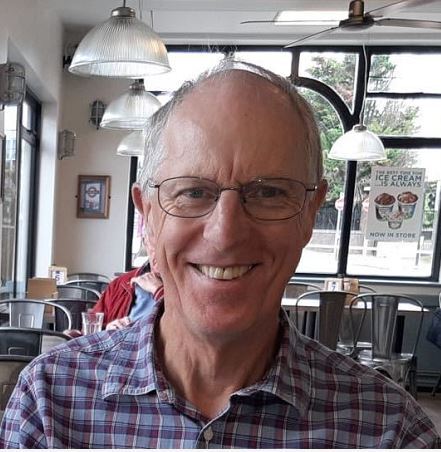Meet Richard Patience – petroleum geochemistry expert

As a teenager, Richard Patience spent a lot of time hiking in the hills of the UK, especially in south Wales where his school owned an old farmhouse. He became interested in the rocks that made up those hills and decided to study geology and chemistry at university.
“However, I hated the antiquated geology course, and dropped it after a year. When I finished my degree in chemistry, I decided I wanted to do something of a more ‘environmental’ nature,” says Richard.
He decided to apply for several jobs in the area but none of those really appealed.
“I was, for example, asked to go to Antarctica for a year as part of one job. Three months in Antarctica would have been great, but one year at the age of 22? No.”
One day he saw an advertisement in New Scientist for a Ph.D. at the Organic Geochemistry Unit with Dr. James Maxwell (later Prof. Maxwell, F.R.S.) in Bristol.
“That was it - rocks and chemistry!”

To Norway – and back
Richard was working for BP in the UK in the late 1980s, and at that time BP Norway was sponsoring the Organic Geochemistry group at the University of Oslo. In those days, it helped foreign oil companies to get leases if they were seen to be doing “good works” in Norwegian society.
“BP asked me to go to the university in Oslo for 6 months, as a BP employee. 6 months became 12 months. The university wanted me to stay on, but they had still not managed to make the position permanent.”
On one occasion, Richard travelled to Stavanger for a meeting, when out of the blue the head of the Organic Geochemistry group in Statoil approached him and offered him a job. He accepted the position and resigned from BP by fax (!).
“I ended up spending ten years in Statoil in Stavanger and speak pretty decent Norwegian as a result, which is not a great deal of use in Houston, Texas,” he admits.
During his career, Richard has written around 50 papers on the topic of organic geochemistry. He is most proud of the 2003 paper “Where did all the coal gas go?” in Org. Geochem. 34, 375-387.
”It’s not necessarily the best paper that my name is on, or the most cited, but it was all my own work (papers normally have co-authors) and I really enjoyed writing it!”
A fateful encounter
Around 1992, Richard met a friend and working colleague that would impact his career – APT co-founder Nigel Mills.
“I met Nigel when he was working for Saga and we worked on several projects together, including the Norwegian Geochemical Standards which was organized by the NPD, Statoil, Hydro and Saga. I vividly recall collecting Jet Rock samples by the kilogram on a beach in Yorkshire with Nigel.”
In 2001, Richard left his position in Statoil and moved to Texas to start working for Unocal, which later became part of Chevron. Working in the Barents Sea especially, he bought data from, and had a fair amount of contact with, Nigel and APT.
“I decided to leave Chevron in late 2015, and asked Nigel if APT wanted a representative in Houston, which he said yes to. So, I was APT’s sole representative here from January 2016 until the appointment of Craig Barrie and Scott Granger, and the formation of APT USA, in 2021.”
According to Richard, people in APT are very good at working together to achieve a common goal.
“It doesn’t mean we have to agree with each other on everything, but we can have technical discussions without it becoming personalized.”
IMAGE 2021
Richard will present at the IMAGE 2021 conference in Denver this month where his talk covers APT’s recent experiences in preparation for production monitoring and allocation of an oilfield in the Norwegian North Sea.
“The field was discovered in the 1980s, and it went into production in the 1990s. However, parts of the field are still under appraisal and development, which means that samples date from the 1980s to 2020,” he says.
APT has analyzed test fluid samples by a range of standard analytical methods, and statistical analysis (Principal Component Analysis) was carried out on all the data, in addition to standard geochemical cross-plots. As a result of this work, a number of positive learnings, as well as pitfalls, emerged.
“Firstly, not all samples described as oil are necessarily oil, and this needs to be established. Secondly, long term storage can do very, and perhaps surprisingly, bad things to oil samples. Thirdly, work ostensibly aimed at production can lead to a new understanding of filling and preservation history, of potential value for exploration. Fourthly, oil family groupings can detect mis-assignment of the formation that an oil comes from. Fifthly, oil-based mud contamination was not an issue in the 1980s, but it is today.”
These very different, and in some cases unexpected, learnings will be presented as a case study on Wednesday 29th September at 11.10am. Don’t forget to sign up for it!
Related Articles
14 Oct 2021

Meet Martin Fowler – geochemistry expert
A good high school chemistry teacher and a colleague with his feet on the desk inspired Martin Fowler to pursue a career in organic geochemistry.
Read more >
13 Jul 2021

Meet Scott Granger – regional manager Americas
APT’s regional manager turns 50 this year, but that doesn’t stop him from taking on new challenges.
Read more >
09 Jul 2021

Meet Craig D. Barrie – shale oil production allocation expert
Earlier this year, Craig joined APT as global product director. At APT, Craig will use his experience from unconventional systems and petroleum geochemistry to support operators in the North American market.
Read more >
27 May 2021

Meet Steve Killops – organic geochemistry expert
Dr. Steve Killops has been active in the field of organic geochemistry for about 35 years, in both academic and commercial sectors. He is a former lecturer in organic geochemistry and today, Steve works as a senior geochemist at APT UK.
Read more >